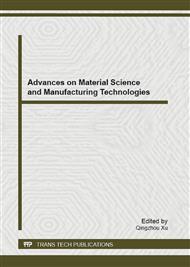[1]
H. D. Burrows, M. Canle L, J. A. Santaballa, S. Steenken, Reaction pathways and mechanisms of photodegradation of pestidides, J. Photochem. Photobiol. B: Biology 67 (2002) 71-108.
DOI: 10.1016/s1011-1344(02)00277-4
Google Scholar
[2]
Y. Jing, L. Li, Q. Zhang, P. Lu, P. Liu, X. Lü, Photocatalytic ozonation of dimethyl phthalate with TiO2 prepared by a hydrothermal method, J. Hazard. Mater. 189 (2011) 40-47.
DOI: 10.1016/j.jhazmat.2011.01.132
Google Scholar
[3]
S. H. Yu, B. Liu, M. S. Mo, et al, General synthesis of single-crystal tungstate nanorods/ nanowires: A facile, low-temperature solution approach, Adv. Funct. Mater. 13 (2003) 639-647.
DOI: 10.1002/adfm.200304373
Google Scholar
[4]
X. Cao, W. Wu, N. Chen, Y. Peng, Y. Liu, An ether sensor utilizing cataluminescence on nanosized ZnWO4, Sensor Actuat B: Chem. 137 (2009) 83-87.
DOI: 10.1016/j.snb.2008.11.020
Google Scholar
[5]
Q. Xiang, J. Yu, M. Jaroniec, Graphene-based semiconductor photocatalysts, Chem. Soc. Rev. 41 (2012) 782-796.
DOI: 10.1039/c1cs15172j
Google Scholar
[6]
D. Chen, Z. Y. Jiang, J. Q. Geng, et al., Carbon and nitrogen co-doped TiO2 with enhanced visible-light photocatalytic activity, Ind. Eng. Chem. Res. 46 (2007) 2741-2746.
DOI: 10.1021/ie061491k
Google Scholar
[7]
H. Fu, J. Lin, L. Zhang, Y. Zhu, Photocatalytic activities of a novel ZnWO4 catalyst prepared by a hydrothermal process, Appl. Catal. A: Gen. 306 (2006) 58-67.
DOI: 10.1016/j.apcata.2006.03.040
Google Scholar
[8]
X. C. Song, Y. F. Zheng, E. Yang, G. Liu, Y. Zhang, H. F. Chen, Y. Y. Zhang, Photocatalytic activities of Cd-doped ZnWO4 nanorods prepared by a hydrothermal process, J. Hazard. Mater. 179 (2010) 1122-1127.
DOI: 10.1016/j.jhazmat.2010.03.123
Google Scholar
[9]
J. A. Rengifo-Herrera, E. Mielczarski, J. Mielczarski, N. C. Castillo, J. Kiwi, C. Pulgarin, Escherichia coli inactivation by N, S co-doped commercial TiO2 powders under UV and visible light. Appl. Catal. B: Environ. 84 (2008) 448-456.
DOI: 10.1016/j.apcatb.2008.04.030
Google Scholar
[10]
G. Williams, B. Seger, P. V. Kamat, TiO2-graphene nanocomposites UV-assisted photocatalytic reduction of graphene oxide, ACS Nano. 2 (2008) 1487-1491.
DOI: 10.1021/nn800251f
Google Scholar
[11]
Y. Cong, F. Chen, J. Zhang, et al., Carbon and nitrogen-codoped TiO2 with high visible light photocatalytic activity, Chem. Lett. 35 (2006) 800.
DOI: 10.1246/cl.2006.800
Google Scholar
[12]
Q. Li, B. Guo, J. Yu, J. Ran, B. Zhang, H. Yan, J. R. Gong, Highly efficient visible-light-driven photocatalytic hydrogen production of CdS-cluster-decorted graphene nanosheets, J. Am. Chem. Soc. 133 (2011) 10878-10884.
DOI: 10.1021/ja2025454
Google Scholar


